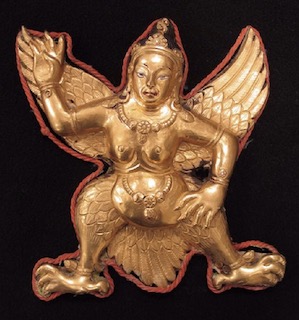Kimnara: Difference between revisions
Jump to navigation
Jump to search
(image from Himalayan art) |
|||
| Line 1: | Line 1: | ||
[[image:kinnara-1.jpg|frame|'''Kimnara''']] | |||
'''Kimnara''' or '''Kinnara''' (Pal. ''kinnara''; Skt. ''kiṃnara''; Tib. [[མིའམ་ཅི་]], ''mi'amchi'', [[Wyl.]] ''mi'am ci'') refers to a class of semi-divine beings that resemble humans to the degree that their very name—which means “Is that a man?”—suggests some confusion as to their divine status. The [[Jatakas]] describe kimnaras as harmless and innocent beings fond of music and song. | '''Kimnara''' or '''Kinnara''' (Pal. ''kinnara''; Skt. ''kiṃnara''; Tib. [[མིའམ་ཅི་]], ''mi'amchi'', [[Wyl.]] ''mi'am ci'') refers to a class of semi-divine beings that resemble humans to the degree that their very name—which means “Is that a man?”—suggests some confusion as to their divine status. The [[Jatakas]] describe kimnaras as harmless and innocent beings fond of music and song. | ||
Latest revision as of 18:45, 21 November 2020

Kimnara or Kinnara (Pal. kinnara; Skt. kiṃnara; Tib. མིའམ་ཅི་, mi'amchi, Wyl. mi'am ci) refers to a class of semi-divine beings that resemble humans to the degree that their very name—which means “Is that a man?”—suggests some confusion as to their divine status. The Jatakas describe kimnaras as harmless and innocent beings fond of music and song.
In some lists, they are classified as one of the eight classes of gods and demons.